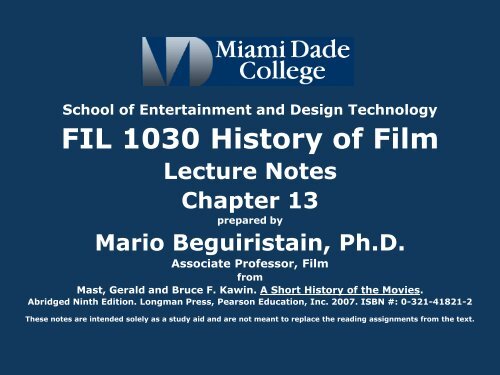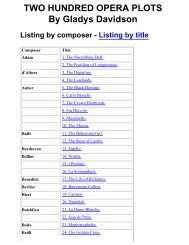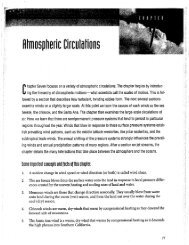FIL 1030 History of Film - MDC Faculty Home Pages
FIL 1030 History of Film - MDC Faculty Home Pages
FIL 1030 History of Film - MDC Faculty Home Pages
You also want an ePaper? Increase the reach of your titles
YUMPU automatically turns print PDFs into web optimized ePapers that Google loves.
School <strong>of</strong> Entertainment and Design Technology<br />
<strong>FIL</strong> <strong>1030</strong> <strong>History</strong> <strong>of</strong> <strong>Film</strong><br />
Lecture Notes<br />
Chapter 13<br />
prepared by<br />
Mario Beguiristain, Ph.D.<br />
Associate Pr<strong>of</strong>essor, <strong>Film</strong><br />
from<br />
Mast, Gerald and Bruce F. Kawin. A Short <strong>History</strong> <strong>of</strong> the Movies.<br />
Abridged Ninth Edition. Longman Press, Pearson Education, Inc. 2007. ISBN #: 0-321-41821-2<br />
These notes are intended solely as a study aid and are not meant to replace the reading assignments from the text.
Chapter 13:<br />
Italian Neo-Realism and the French New Wave<br />
After World War II:<br />
American films in transition<br />
European Cinema emerges as “best, serious, quality cinema”<br />
Cultural snobbism: “ART Theaters”<br />
European <strong>Film</strong>s vs. American <strong>Film</strong>s:<br />
American <strong>Film</strong>s: considered escapist fare, entertainment, narrative driven, frivolous.<br />
European <strong>Film</strong>s: seen as realistic, serious, worthy <strong>of</strong> study, intellectually engaging.<br />
Realism = Art<br />
Mast: “European films structured themselves around a theme or a psychological<br />
problem, more than around a story.”
Italian Neo-Realism<br />
Precedents:<br />
Mussolini establishes Cinecittà<br />
Centro Sperimentale (first film school)<br />
White Telephone comedies<br />
U.S. films were banned<br />
Devastated Post-War Italy:<br />
Unemployment, poverty and scarcity<br />
Cinecittà Studios Front Gate<br />
Centro Sperimentale,<br />
the world’s first film school<br />
Vittorio De Sica became a matinee idol in Ai Vostri Ordni,<br />
Signora! (1939) and Il Signor Max (1937). Invariably set onboard<br />
liners or in hotels or nightclubs, these "white telephone" pictures<br />
gently mocked the upper-classes.<br />
Aerial view <strong>of</strong> Cinecittà Studios outside <strong>of</strong> Rome<br />
Cesare Zavattini defined the principles <strong>of</strong> Neo-Realism (p.328):<br />
“To show things as they are, not as they seem, nor as the bourgeois would prefer them to appear;<br />
to write fictions about the human side <strong>of</strong> representative social, political, and economic conditions;<br />
to shoot on location wherever possible; to use untrained actors in the majority <strong>of</strong> the roles; to capture<br />
and reflect reality with little or no compromise; to depict common people rather than overdressed<br />
heroes and fantasy role models; to reveal the everyday rather than the exceptional; and to show a<br />
person’s relationship to the real social environment rather than to his or her romantic dreams.”
Roberto Rossellini<br />
Post-War Neo-Realist Trilogy:<br />
“Open City” (1945): Ana Magnani: Resistance in Rome<br />
“Paisan” (1946): Six stories on Allied Invasion and Nazi retreat<br />
“Germany Year Zero” (1947): Hungry boy lives in Berlin rubble<br />
“The Miracle” (1948)<br />
Anna Magnani is a crazed peasant woman who claims her pregnancy is the result <strong>of</strong> immaculate conception.<br />
Rossellini intended this film to be a study <strong>of</strong> personal faith in the face <strong>of</strong> social ridicule but the film was<br />
denounced by the New York Catholic League as "heretical", Protests, bomb scares and the threat <strong>of</strong> fines and<br />
jail terms (possible at the time since films were not protected as free speech under the first Amendment)<br />
forced the distributors to initiate a landmark lawsuit. The case, which went to the Supreme Court, established<br />
for the first time that film was a form <strong>of</strong> speech protected by the First Amendment.<br />
The Ingrid Bergman scandal and their collaboration:<br />
“Stromboli” (1949): Bergman goes to live on an island and faces repudiation<br />
“The Greatest Love” (1952)<br />
“Ingrid Bergman” (1953) Episode in We, the Women with Bergman as herself.<br />
“Voyage to Italy” (1953) Starring Ingrid Bergman and George Sanders.<br />
“Joan <strong>of</strong> Arc at the Stake” (1954)<br />
“La Paura” (Fear) (1954) Last Rossellini film starring Ingrid Bergman. “Stromboli”
Vittorio De Sica and Cesare Zavattini<br />
The former White Telephone Comedy leading man joins<br />
the socialist writer and they become the standard bearers<br />
<strong>of</strong> Italian Neo-Realism.<br />
“Shoeshine” (1946)<br />
“The Bicycle Thief” (1948)<br />
“Miracle in Milan” (1950)<br />
“Umberto D.” (1952)<br />
Vittorio De Sica Cesare Zavattini<br />
The<br />
Bicycle<br />
Thief<br />
André Bazin on “Umberto D.” :<br />
"I have no hesitation in stating that the cinema has<br />
rarely gone such a long way toward making us<br />
aware <strong>of</strong> what it is to be a man. And also, for that<br />
matter, <strong>of</strong> what it is to be a dog."
Luchino Visconti<br />
Aristocratic parlor communist with an operatic gay sensibility.<br />
Neo-Realism:<br />
“Ossessione” (1942) (The Postman Always Rings Twice)<br />
Regarded as the first Neo-Realist film<br />
“La Terra Trema” (1948)<br />
“Rocco and His Brothers” (1960)<br />
Lavish historical melodramas: Decadence, perversion and homosexuality:
“La Strada”<br />
Federico Fellini<br />
From grungy Neo-Realism to<br />
a hallucinogenic dream world<br />
“I Vitelloni” (1953)<br />
“La Strada” (1954) (Oscar)<br />
“Nights <strong>of</strong> Cabiria” (1956)<br />
“La Dolce Vita” (1960)<br />
“8 1/2” (1963) (Oscar)<br />
“Juliet <strong>of</strong> the Spirits” (1965)<br />
“Satyricon” (1970)<br />
“Nights <strong>of</strong> Cabiria” “La Dolce Vita” “8 1/2” “Satyricon”
Michelangelo Antonioni<br />
Post-Neo-Realist. A visual master who<br />
captured the emotional void at the heart<br />
<strong>of</strong> the upper classes.<br />
“Red Desert” (1964)<br />
(First Color <strong>Film</strong>)<br />
The Trilogy<br />
<strong>of</strong> Alienation:<br />
“L’Avventura” (1960)<br />
“La Notte” ( 1961)<br />
“L’Eclisse” (1962)<br />
In England:<br />
“Blow-Up” (1968)<br />
In The U.S.A:<br />
“Zabriskie Point” (1970)
Post-War France<br />
I. Post-War Classicism<br />
Max Ophuls<br />
“La Ronde” (1950)<br />
“The Earrings <strong>of</strong><br />
Madame D.” (1953)<br />
“Lola Montes” (1955)<br />
Jacques Tati<br />
“Mr. Hulot’s Holiday”<br />
(1953)<br />
“Mon Oncle” (1958)<br />
“Playtime” (1967)<br />
Jean Cocteau<br />
“Beauty and the Beast” (1946)
André Bazin<br />
Critic who argued<br />
that film was art<br />
and the artist<br />
was the director.<br />
Laid down the<br />
precepts for<br />
“The Auteur Theory.”<br />
II. Cahiers du Cinéma and the “Auteur” Theory <strong>of</strong> <strong>Film</strong> Criticism<br />
Founded in Paris in 1951 by Jacques Doniol-Valcroze, Lo Duca, and legendary film critic and theorist André Bazin, Cahiers du cinéma - literally<br />
"cinema notebooks" - has been the most influential film magazine in the history <strong>of</strong> the art form <strong>of</strong> cinema. The ideas championed on its pages<br />
have revolutionized film theory and criticism and filmmaking practice, and helped give rise to much <strong>of</strong> what we think <strong>of</strong> as serious film culture<br />
today. Indeed, Cahiers has played an instrumental role in the development <strong>of</strong> the very idea <strong>of</strong> cinema as an art form.<br />
It was in Cahiers du cinéma that a now-celebrated coterie <strong>of</strong> young, <strong>of</strong>ten fiercely polemical critics - Jacques Rivette, Eric Rohmer, François<br />
Truffaut, Jean Luc Godard, and Claude Chabrol most prominent among them - began attacking the hidebound, safe and highly literary "tradition<br />
<strong>of</strong> quality" then predominant in French filmmaking (which they disparaged as cinéma de papa, or papa's cinema). Their cinephile sensibilities<br />
cultivated by countless nights viewing Hollywood and international achievements at Henri Langlois's Cinémathèque Française, they began<br />
advocating a radical new notion, la politique des auteurs - or auteur theory - that advanced cinema as a distinctive creative form with its own<br />
language and means <strong>of</strong> personal artistic expression (cinema was not simply a bastard art, a form <strong>of</strong> literature with pictures, or <strong>of</strong> filmed theatre);<br />
argued that it was the director who was the author, or artist, or creative force <strong>of</strong> this medium; and put forth the then-revolutionary idea that<br />
American genre filmmakers and craftsmen such as Howard Hawks and Alfred Hitchcock, with their dynamic styles and highly personal<br />
signatures, were true masters <strong>of</strong> the art. (The Cahiers critics were also great proponents <strong>of</strong> more personal, individualistic French talents such as<br />
Renoir, Vigo, Cocteau, Tati, and Bresson).<br />
Most famously, at the end <strong>of</strong> 1950s, these young talents put the aesthetic ideas and film- wonk sensibilities they had promulgated on the pages<br />
<strong>of</strong> Cahiers into glorious filmmaking practice, giving birth to the great creative explosion known as the nouvelle vague, the French New Wave.
III. The French New Wave<br />
Francois Truffaut<br />
New Wave Splash:<br />
• “The 400 Blows” (1959)<br />
• “Shoot The Piano Player” (1960)<br />
• “Jules and Jim” (1962<br />
The Adventures<br />
<strong>of</strong> Antoine Doinel:<br />
• “The 400 Blows” (1959)<br />
• “Antoine and Colette”<br />
• “Stolen Kisses” (1968)<br />
• “Bed and Board” (1970)<br />
• “Love on the Run” (1979)<br />
Audience Favorites:<br />
• “Day for Night” (1973)<br />
• “The Last Metro” (1980)<br />
Homages to Hitchcock:<br />
• “Fahrenheit 451” (1966)<br />
• “Bride Wore Black (1968)<br />
• “Mississippi Mermaid”<br />
(1969)
III. The French New Wave<br />
Alain Resnais<br />
Obsessed with memory and time<br />
“Hiroshima Mon Amour” (1959)<br />
“Last Year at Marienbad” (1961)<br />
“La Guerre Est Finie” (1966)<br />
“Stavisky” (1974)<br />
“Providence” (English) (1977)<br />
Last Year at Marienbad<br />
Hiroshima Mon Amour
III. The French New Wave<br />
Jean Luc Godard<br />
Enfant terrible <strong>of</strong> the New Wave<br />
“Breathless” (1959)<br />
“Contempt” (1963)<br />
“Pierrot Le Fou” (1965)<br />
“Alphaville” (1965)<br />
“Weekend” (1967)<br />
Contempt
<strong>FIL</strong> <strong>1030</strong> <strong>History</strong> <strong>of</strong> <strong>Film</strong><br />
Lecture Notes<br />
Chapter 13<br />
“The End”<br />
If you wish to continue with the next chapters:<br />
1. Click on your browser’s “back” button to return to the Syllabus<br />
2. Click on the button at the top <strong>of</strong> the syllabus for the next chapters













